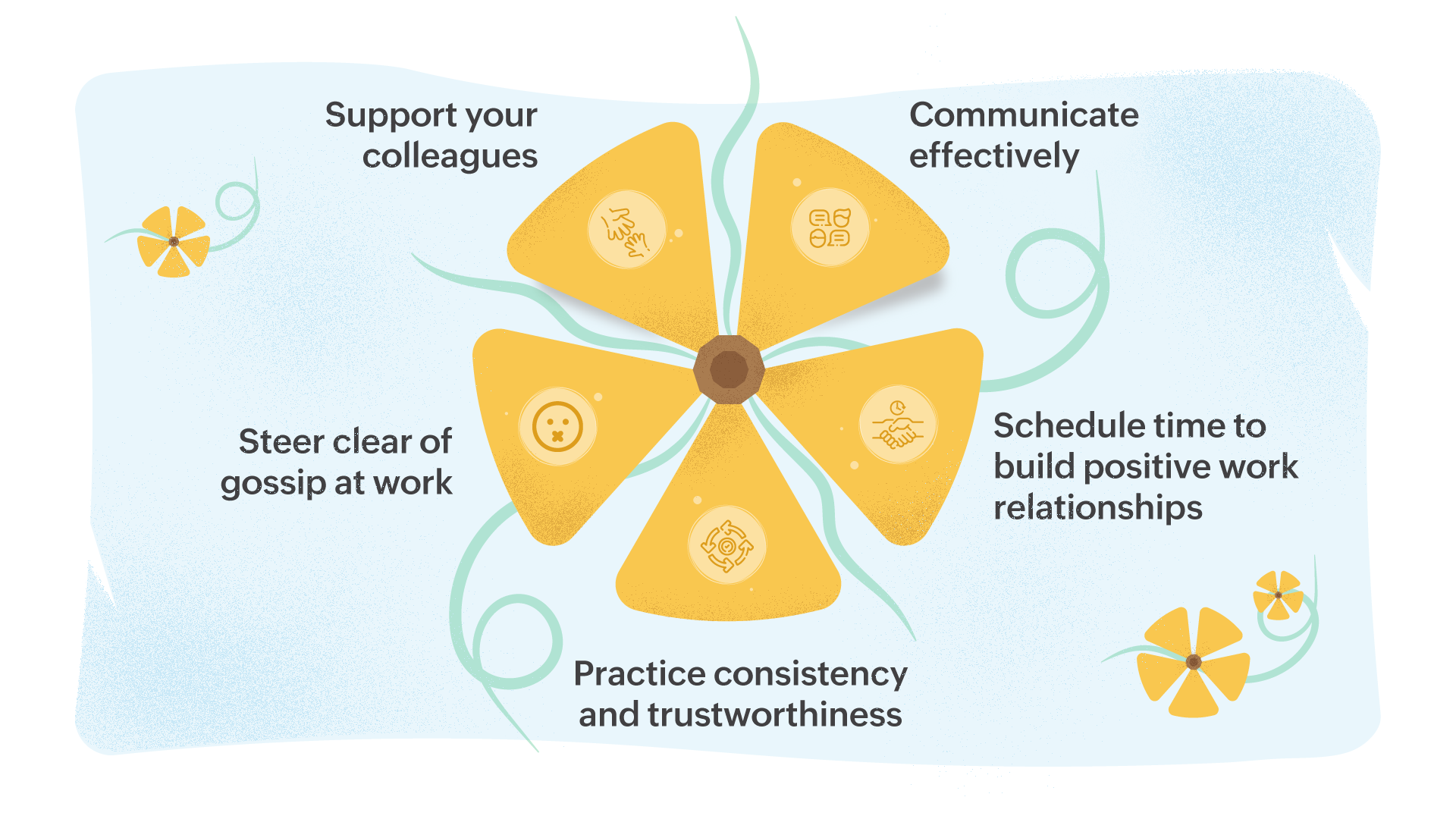75
Chapter Essential Questions
What must a good leader understand about themselves?
What must a good leader know about the organization they are a leader of?
How do good leaders build relationships?
Why is creating vision important for leadership?
How does a leader manage day to day duties, relationships and operations of the teams?
Lesson 3: Interpersonal skills
Lesson Outcomes
By the end of this module, you should be able to:
- Describe how to build rapport in relationships;
- Discuss current strengths and opportunities for development in building relationships as a manager;
- Describe techniques for improving interpersonal skills and relationship building (relationship management activities);
- Discuss the value of diversity across the team.
Building a Rapport At Work
Rapport is often referred to the capability to relate to others in a way that generates a level of belief and understanding. It is being approachable to all at an unconscious level. It is critical to build rapport with your co-workers and clients as it sets the stage for them to begin receiving and beginning the practice of recommendations. At its core, rapport allows clients and co-workers to feel contented, peaceful and are open to suggestions.
There are certain skills that are considered the most important when building rapport. The important communication skills that are required for rapport building have been stated as follows: (Communication Skills for Building Rapport During Contact Investigation Interviewing, n.d.).
Principals of Building Rapport
- Develop an attractive personality;
- Become genuinely interested in other people;
- Aim to meet the other persons needs;
- Become an excellent communicator;
- Create similarities between you and the other person;
- Learn to adapt your behavior’s;
- Create Trust.
Efficient rapport building in the workplace is crucial and Bakic-Miric and Bakic (2008) identify seven vital components:
- Build the Relationship
- Open the Discussion
- Gather Information
- Understanding of Other’s Requirements
- Share Information
- Reach Agreement on Problems and Plans
- Mindful Work Building relationships leads to trust and better communication, discussing tasks and functions clarifies doubts and enables organized implementation.
Gathering information is necessary for various jobs. Understanding others’ requirements and needs, sharing information, and peaceful resolution of conflicts lead to better outcomes and knowledge enhancement. Mindful work involves enthusiastic and responsible performance at all levels.
Building Effective Working Relationships
Developing strong workplace relationships is a crucial skill for employees, as it can impact negotiating success, project delivery, and meeting deadlines. This article outlines the essential components of successful working partnerships and provides practical tips to improve existing relationships. Try out the exercise below to find out the most critical pieces to effective working relationships.
Relationship Building is working to build or maintain ethical relationships or networks or contacts with people who are, or may be, potentially helpful in achieving work-related goals and establishing advantages. These people may include customers, clients, counterparts, colleagues, etc.
5 simple guidelines for employees to build and nurture healthy work relationships
Lakshmi, S. (n.d.). https://www.zoho.com/blog/cliq/5-guidelines-for-employees-to-build-healthy-work-relationships.html. Retrieved July 17, 2023, from https://www.zoho.com/blog/cliq/5-guidelines-for-employees-to-build-healthy-work-relationships.html.
Effective communication is a key factor in cultivating robust work relationships, which encompasses active listening as much as talking. To engage in meaningful communication, listen attentively to your colleagues or superiors, keeping an open mind and considering their input before responding. Asking thoughtful questions fosters open communication and allows you to learn more about the other person, making it easier for your team members to confide in you, discuss work-related concerns, share achievements, and more.
Creating positive work relationships requires dedication and perseverance, and finding opportunities to socialize with colleagues may seem challenging amidst your daily tasks and duties. However, setting aside time to interact with your coworkers can promote healthy relationships. Consider scheduling a coffee break or dedicating ten minutes before or after work to socializing, or creatively incorporating this practice into team meetings.
Establishment of trust is the cornerstone of any relationship hence it is crucial to consistently exhibit reliability in your team relationships. Building robust work relationships is attainable when your colleagues can trust and depend on you.
Toxicity in the workplace can be caused by gossiping even though it may seem harmless initially. If you encounter an issue with a coworker, you must handle it transparently and professionally instead of indulging in gossip about them. Engaging in gossiping may diminish your reliability before your teammates and can lead to damaging work relationships.
When presented with the opportunity, always endeavor to support and aid your coworkers. By assisting colleagues who may be overwhelmed with their tasks, you create a stronger connection within the team. Rendering help when needed reinforces your dependability, boosts morale, and cultivates an overall positive work environment. Furthermore, lending a helping hand to others may encourage them to support you when necessary, fostering a more productive and collaborative team.
Interpersonal Skills
Interpersonal skills are the abilities used daily in communicating and engaging with others, individually or in groups. Proficient individuals tend to lead prosperous lives both in their professional and personal capacity. Interpersonal skills comprehend various skills, with many focusing on communication, namely listening, questioning, and comprehending body language. Emotional intelligence skills, including managing one’s emotions and empathizing with others, are also part of this skill set. Effective relational skills enable individuals to collaborate amicably in teams and groups, expressing themselves coherently with family, colleagues, customers, or clients. Interpersonal skills are critical in various areas of life, ranging from work, education, and social circles. By understanding how to interact with others consciously and practicing, you can improve your interpersonal skills.
Interpersonal skills encompass an extensive range of abilities, including:
Communication, which consists of:
- Verbal communication – the words we use and how we deliver them;
- Non-verbal communication – what we convey without words, such as body language and tone of voice;
Listening skills – how we interpret and comprehend verbal and non-verbal messages from others.
Emotional intelligence – the capacity to understand and regulate one’s and others’ emotions.
Teamwork – the ability to collaborate with others in formal and informal groups or teams.
Negotiation, persuasion, and influence – working with others to achieve a mutually satisfactory outcome. Although it is a form of communication, it is frequently treated as a separate skill set.
Conflict resolution and mediation – engaging with others to resolve interpersonal conflicts and disputes positively. Again, it could be classified as a form of communication.
Problem-solving and decision-making – working with others to identify, define and resolve issues, including determining the best course of action.

Why Diversity is Critical
Having a diverse workforce brings together individuals with distinct backgrounds, experiences, perspectives, and methods of problem-solving. This variety of thinking encourages creativity and leads to innovative solutions. Teams that are diverse are more likely to produce fresh concepts and create original approaches to confront challenges.
The United Nations acknowledges over thirty traits that exemplify diversity, but in reality, there are countless more. Some are visible, while others are not, and some are innate parts of our identity, while others fluctuate over our lifetime. In general, diversity is categorized into four types: internal, external, organizational, and worldview.
Internal diversity relates to characteristics that an individual is born with, such as gender, race, ethnicity, sexual orientation, physical ability, nationality, and other legally protected features.
External diversity consists of features that shape a person’s identity but were not present at birth, including socioeconomic status, education, marital status, appearance, religion, and location. These factors are often influenced by others and may change throughout a person’s life.
Organizational diversity pertains to distinctions in job function, work experience, seniority, department, or managerial level within a company. Homogeneous teams with similar backgrounds or experiences may exist in certain departments or levels.
Lastly, worldview diversity encompasses a wide range of beliefs, political affiliations, culture, and travel experiences. It affects the way we interpret and understand the world and contributes to a creative, inclusive work environment that is forward-thinking.
“I think it’s about recognizing that with greater diversity we should have more perspectives. We should have lots of different things and in fact we might have more discomfort and more conflict. But it’s about providing people with the tools and the understanding, so they become conflict-competent and not conflict-averse — and understanding how sometimes that conflict can be used for innovation and spreading new growth.”
Workplace Strategies for Diversity
- Be flexible about how, where, and when people work (might include work-from-home policies).
- Offer and strengthen the supports and benefits available to all workers (such as sick days).
- Modify the work environment to support all the tasks your organization carries out (might include private space and space for meetings or collaboration).
- Give workers the chance to share opinions and ideas in a way that is valued and heard by decision makers.
- Create ways for employees to support, reward, and recognize one another (might include team-building and informal gatherings).
- Identify and uphold the benefits of diversity when trying to promote inclusivity.
- Calculate and share the expected return on investment (in broad terms) and how small steps can positively affect everyone in the organization.
Workplaces and organizations that support diversity and inclusion prioritize safe spaces, cultivate supportive work relationships, and engage employees regardless of differences. Providing adequate support for all employees, regardless of whether they’ve disclosed their needs, is crucial. Given that organizations vary, they require different approaches when supporting workers’ primary needs. This may involve providing a quiet workspace, an open area for collaboration and support, or sufficient access to natural light. It’s crucial to listen to these needs and offer an appropriate range of options. Consider incorporating diverse spaces for different tasks or designing workspaces to accommodate these needs.
For more multifaceted issues, such as living with mental illness, a plan to address change is critical. Resistance to accommodating such workers is common, often stemming from a lack of understanding about why these accommodations are worthwhile. Communicating the benefits of diversity, such as innovation and development, can be helpful in addressing such resistance and educating workers about mental illness.
Journal Prompt
Using the forum labelled “Course 6: Lesson 3″ make a journal entry responding to the prompt below. Ensure that you title the entry “Lesson 3”. After writing a journal entry, go and make a comment on two other posts from your classmates. It can be about anything you noticed, liked, agreed with etc. The idea is to continue the dialogue about the topic.
Thinking about work, answer the following questions:
Who is under-represented or not involved in your team? Why is that?
What are some potentially negative impacts of under-representation in your team?
What do you think needs to be done to make your team more inclusive or diverse? What support might people need in order to become more involved on your team or with your work?
Who can you ask for guidance and support in addressing underrepresentation and supporting the participation of more diverse community members.

